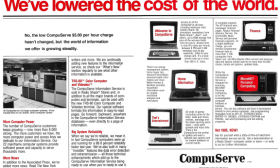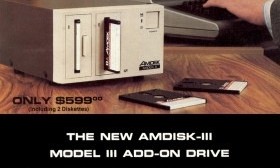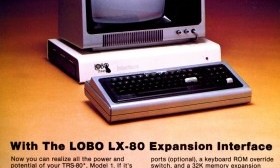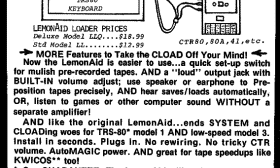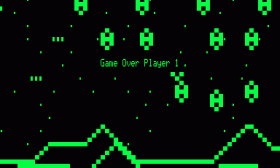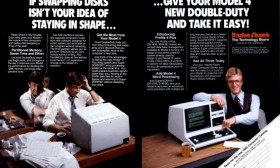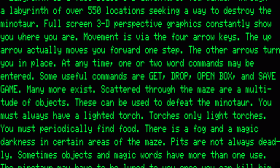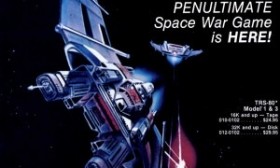CompuServe was the most famous of the early online services and the one with closest ties to the TRS-80. It actually started in 1969 as a timesharing system, renting mainframe computer time to businesses over phone lines. However, what most people remember as CompuServe dates to August 1979, launched as an online service for microcomputer users named MicroNET.
MicroNET opened the CompuServe network, normally reserved for businesses, to consumers with a telephone modem. Access was only available outside of business hours, when their mainframes were normally idle. MicroNET provided more or less raw access to the CompuServe mainframes running the TOPS-10 operating system. Users could use the included programs or create and run their own programs on the system.
(Read more...)
The Amdisk-III was an external dual-3″ (not 3 1/2″) floppy disk system introduced by Amdek Corporation in 1982. The TRS-80 Model III version was originally priced at $899, but that price was soon reduced to $599.00 and later $499.00. Versions were also available for the TRS-80 Color Computer, the IBM PC, and the Atari 400/800. 80 Micro tested a prototype version for the Model I, but it is unclear if that Model I version was ever sold. Amdisk also sold a single-drive system, the Amdisk-I, that was only available for the Apple II.
In 1982 to 1983, there were four “microfloppy” formats competing to replace the 5 1/4" floppy:
(Read more...)
The LX-80 was an alternative to the Radio Shack Expansion Interface that took a different approach to compatibility than the competition. It was originally announced by Lobo Drives International in Fall of 1979, but problems with the supplied operating system meant that it wasn’t released until closer to 1981. The original price was $799 (without memory), although that price had been reduced to $510.00 by late 1982. Lobo Drives also briefly advertised the LX-50, but it is unclear how that differed from the LX-80.
The LX-80 unit was extremely solid (constructed of 1/8″ thick steel) and was designed to have the Model I monitor rest on top. Although more expensive than other Expansion Interfaces, the LX-80 came with an impressive set of features:
(Read more...)
The LemonAid Loader was a device which greatly improved the ability of the TRS-80 to load programs using a CTR-80 or CTR-80A cassette recorder. It was designed by Wayne Lemons and sold through his company, Lemons Tech Services. The LemonAid Loader was available in two versions: the original which cost $12.99 (later $19.99) and a “deluxe” improved version which cost $18.99 (later $23.50). Both versions were compatible with the Model I and Model III, although cassette filtering was especially useful on the Model I.
The LemonAid Loader was described this way by a product announcement:
(Read more...)
The original version of Rear Guard was written by Neil Larimer for the Apple II. It was released by Adventure International, Scott Adams' company, which also commissioned versions for other computers:
- John Anderson wrote the Atari 400/800 version
- Jim Hurd wrote the TRS-80 Color Computer version
- Wayne Westmoreland and Terry Gilman wrote the TRS-80 Model I/III version
One Adventure International advertisement described Rear Guard this way:
(Read more...)
DoubleDuty is a utility that uses the full 128K of a TRS-80 Model 4 to allow more than one program to be run at one time. Introduced by Radio Shack in 1984, DoubleDuty was written by Randy Cook, the author of Model I TRSDOS and VTOS.
DoubleDuty works by creating three sections, called partitions, out of the Model 4 memory. Partitions one and two each contain a complete Model 4 TRSDOS system. The third partition is reserved for running TRSDOS library commands.
(Read more...)
Labyrinth was the second game in the “Continuum Series,” a set of 3-D adventures sold by Med Systems Software. It was preceded in the series by Deathmaze 5000 and followed by Asylum and Asylum II. Like most of their games, Med Systems also sold tape and disk versions of Labyrinth for the Apple II.
Labyrinth was in many ways a continuation of Deathmaze 5000. Once again, the player is trapped in a gigantic maze which contains numerous dangers. This time, the primary goal is to defeat the Minotaur, a half-bull, half-man creature from Greek mythology.
(Read more...)
The “New Products” section in the TRS-80 magazine 80 Microcomputing was a listing of new product releases, described this way:
The New Products section is intended to inform our readers of new products on the market. All information in the section is taken from product releases sent by manufacturers.
But starting in 1982, every April issue included several gag products mixed in with the usual announcements. Here are just a few of those “April Fool’s” new products.
(Read more...)
Starfighter, written by Sparky Starks, falls somewhere between an arcade game and a simulation. Far more than a shoot-em-up game, the incredibly detailed scenario in Starfighter lends itself to a game that can be played for hours. Although a unique game, Starfighter has some similarities to Star Raiders, a 1979 game for the Atari 800 that was written by Doug Neubauer.
Sparky Starks later wrote a version of Starfighter for the Atari 400/800 using the name Destiny: The Cruiser. A new name was required because Adventure International had already sold the rights to the name Starfighter to be used by the movie The Last Starfighter.
The goal in Starfighter is to pilot a spacecraft, the SC-78503 Starfighter, and destroy hostile enemy spacecraft. From a description in an Adventure International catalog:
(Read more...)
